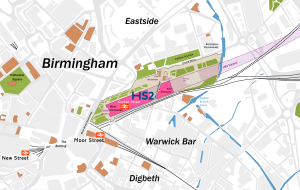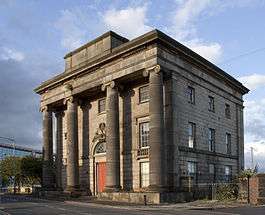Birmingham Curzon Street railway station
Birmingham Curzon Street railway station is the planned northern terminus of Phase 1 of High Speed 2 in the city centre of Birmingham, England. The new railway will connect Birmingham to London Euston via Birmingham Interchange and Old Oak Common. Curzon Street will have seven terminal platforms and is planned to open in 2026.[1]
| Birmingham Curzon Street | |
|---|---|
 Future station layout and relation to the city | |
| Location | |
| Place | Birmingham, England |
| Local authority | City of Birmingham |
| Coordinates | 52.4815°N 1.8853°W |
| Grid reference | SP078870 |
| Operations | |
| Number of platforms | 7 |
| History | |
| 2026 | Planned opening |
| National Rail – UK railway stations | |
The station, the design for which has been developed by WSP and Grimshaw Architects, will be surrounded by new public spaces, include a pedestrian link to Birmingham Moor Street, and be integrated with an extended West Midlands Metro tram network.[2]
Birmingham City Council plans to use the location of the new station to promote development within the city, especially the redevelopment of the Eastside and Digbeth areas.[3]
History
Site

.jpg)
The station will be constructed on land bounded by Curzon Street, Eastside Park & Moor Street Queensway, built partially on the site of the former Curzon Street railway station, historically the first station serving London to Birmingham trains. The remaining Classical stone entrance building is now a Grade I listed building, applied by Historic England for "buildings of exceptional interest".[4]
The site is located to the east of the city centre, in the Eastside and Digbeth areas, in the valley of the River Rea. It was densely developed until the late 20th century and is the most historically industrialised area of the city; the Grand Union Canal arrived in the 18th century, and the London and North Western, Midland and Great Western railways were all built through this part of the city in the 19th century.[5][6]
The character of the site and surroundings has been in transition in recent years. Eastside has focused on learning and innovation, and is the location of Birmingham City University, Aston University and the ThinkTank science museum. Digbeth is covered by a conservation area, marking it historically important in respect of its distinct character.[6] Digbeth has become an arts and technology hub. The Digbeth Branch Canal is located to the east of the site, connecting to the wider city network.[6]
A large proportion of the site has remained brownfield or car parking, retaining only remnants of its previous industrial use. The site was also the location of the Park Street Gardens Burial Grounds which has been removed as part of the site remediation works. As well as the entrance of the 1838 station, the neighbouring Grade II listed pub, The Woodman,[7] will be incorporated into the redevelopment; the Fox & Grapes, a listed pub previously situated on Park Street, was demolished in 2018, which attracted strong criticism.[8][9]
Construction
Construction is due to complete in 2026–29.
At the start of 2019 the site was cleared. Like at all HS2 sites, an extensive archaeological programme, this one involving 70 archaeologists, followed and unearthed what is thought to be the world's oldest railway roundhouse adjacent to the old Curzon Street station. Built to a design by the 19th century engineer Robert Stephenson, the roundhouse was operational on 12 November 1837 – predating the current titleholder of "world's oldest" in Derby by almost two years.[10] Other demolitions and ground investigations are preparing the site for construction, and utility diversions are set to begin in summer 2020.[2]
The tender for the main construction contractor was opened by HS2 in January 2020 for £571m. HS2 was forced to halt the original procurement process the previous July due to a "lower-than-anticipated market appetite" from bidders.[11]
In April 2020, planning permission for the new station, including concourses, roof, viaduct, and platforms was granted by the City Council, the first HS2 station to gain it. The Council's report concluded "the [station design is] truly world class. The elegant and (deceptively) simple form of the main station building clearly reads as a railway station and harks back to traditional station architecture, delivering this in a confident and contemporary way".[2]
Design
The design for Curzon Street station was developed by the consultancy WSP and Grimshaw Architects for High Speed 2. Initial designs were consulted on in autumn 2018 and evolved ones in January 2020.[2] The station building is roughly oriented north east to south west. The principal train shed consists of an arched roof, intended to be the architectural signature of the station, clad in metal panels with a significant projection both at the east and western ends of around 35 m (115 ft). The railway line will continue eastwards elevated on a viaduct over Park Street and New Canal Street, with retail, trams and public space beneath. The old Curzon Street station will be incorporated into the eastern entrance of the new station and connected using a masonry colonnade screen between the historic structure and the new HS2 station viaducts and eastern concourse at New Canal Street. The renovated building will have a visitor centre and office space that will be used by HS2 Ltd, Birmingham City University and Historic England.[12]
The design also improves access to different modes of transport: the West Midlands Metro tram service will run alongside and underneath the station, while accessible pedestrian routes lead to local bus services, Sprint rapid transit bus services and other train services. Cycle parking has also been incorporated, providing space for more than 550 bicycles.[2] The new station is planned to be net zero carbon in operation, and is designed to meet BREEAM Excellent, an industry standard for buildings that reduce energy usage and materials waste, and minimise impact on the natural environment.
Services
High Speed 2 | |||||||||||||||||||||||||||||||||||||||||||||||||||||||||||||||||||||||||||||||||||||||||||||||||||||||||||||||||||||||||||||||||||||||||||||||||||||||||||
|---|---|---|---|---|---|---|---|---|---|---|---|---|---|---|---|---|---|---|---|---|---|---|---|---|---|---|---|---|---|---|---|---|---|---|---|---|---|---|---|---|---|---|---|---|---|---|---|---|---|---|---|---|---|---|---|---|---|---|---|---|---|---|---|---|---|---|---|---|---|---|---|---|---|---|---|---|---|---|---|---|---|---|---|---|---|---|---|---|---|---|---|---|---|---|---|---|---|---|---|---|---|---|---|---|---|---|---|---|---|---|---|---|---|---|---|---|---|---|---|---|---|---|---|---|---|---|---|---|---|---|---|---|---|---|---|---|---|---|---|---|---|---|---|---|---|---|---|---|---|---|---|---|---|---|---|
| |||||||||||||||||||||||||||||||||||||||||||||||||||||||||||||||||||||||||||||||||||||||||||||||||||||||||||||||||||||||||||||||||||||||||||||||||||||||||||
Eventually, there will be nine trains per hour onto the high speed network in each direction from the station.
References
| Wikimedia Commons has media related to Curzon Street railway station. |
- HS2 Phase One Environmental Statement - Non-technical summary (PDF) (Report). HS2 Ltd. November 2013. p. 13. Retrieved 19 February 2018.
- "Curzon Street station becomes first HS2 station to gain planning approval". Rail Professional. 23 April 2020. Retrieved 16 May 2020.
- Birmingham Curzon HS2 Masterplan for growth (PDF) (Report). Birmingham City Council. February 2014. p. 3. Retrieved 16 April 2018.
- Historic England. "Curzon Street: The former Principal Building of the Birmingham Terminus for the London-Birmingham Railway (1343086)". National Heritage List for England. Retrieved 20 April 2020.
- Kellett, John R. (1969). The Impact of Railways on Victorian Cities. Routledge.
- "Digbeth, Deritend and Bordesley High Streets Conservation Area Character Appraisal" (PDF). Birmingham City Council. March 2009.
- Birmingham Curzon HS2 Masterplan for growth (PDF) (Report). Birmingham City Council. February 2014. p. 14. Retrieved 16 April 2018.
- Young, Graham (14 September 2018). "Outrage at demolition of landmark city centre pub". Birmingham Mail. Retrieved 27 February 2019.
- "Roads closed as demolition work begins to make way for HS2". bbc news. 15 September 2018. Retrieved 16 October 2018.
- "Curzon Street station archaeology". High Speed 2. 10 March 2020. Retrieved 16 May 2020.
- Kelly, Megan (24 January 2020). "HS2 reopens bidding for Curzon Street with higher contract value". Construction News. Retrieved 16 May 2020.
- "Local Area Engagement Plan: Birmingham 2019" (PDF). High Speed 2. p. 3. Archived from the original (PDF) on 16 May 2020. Retrieved 16 May 2020.